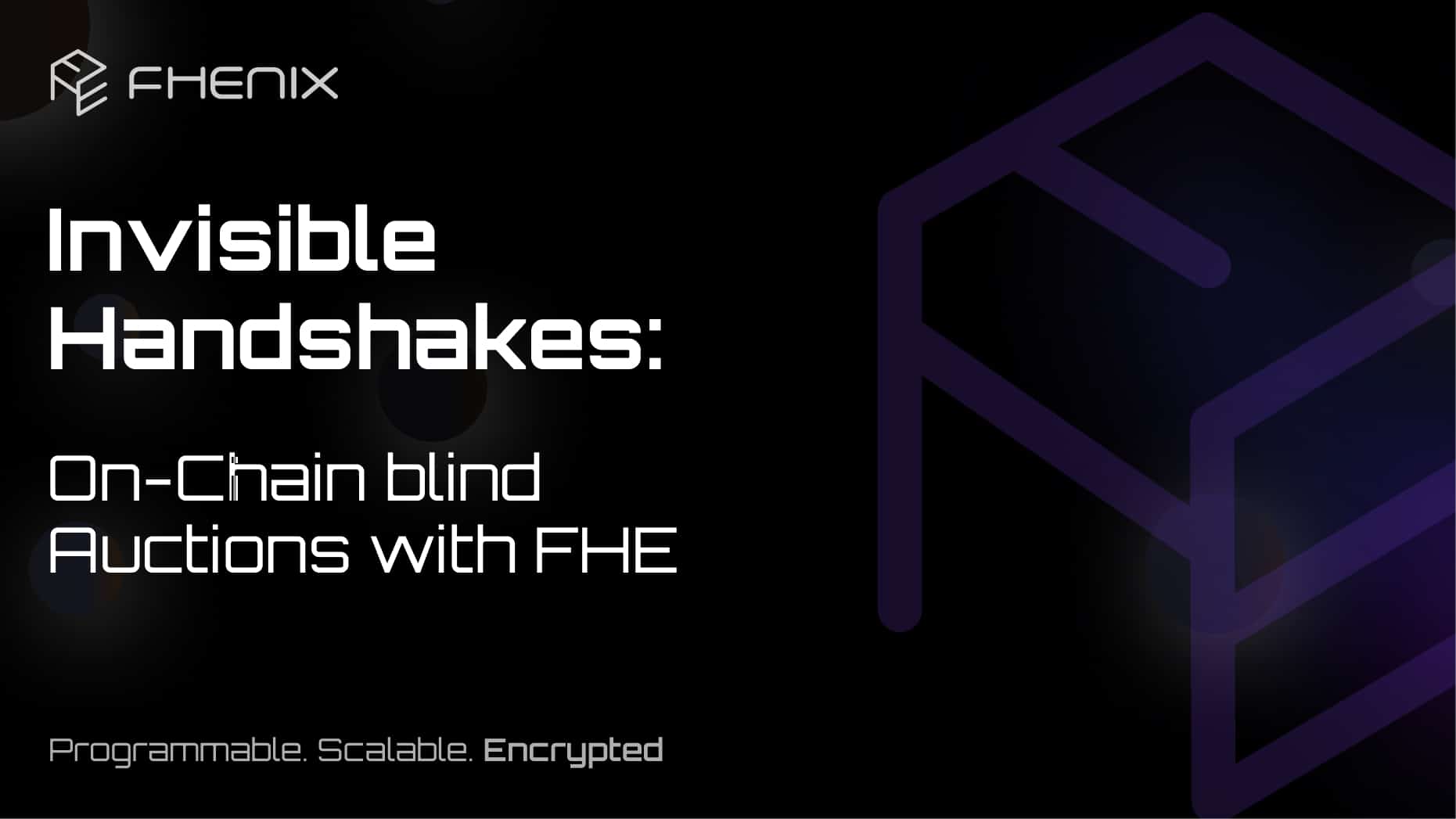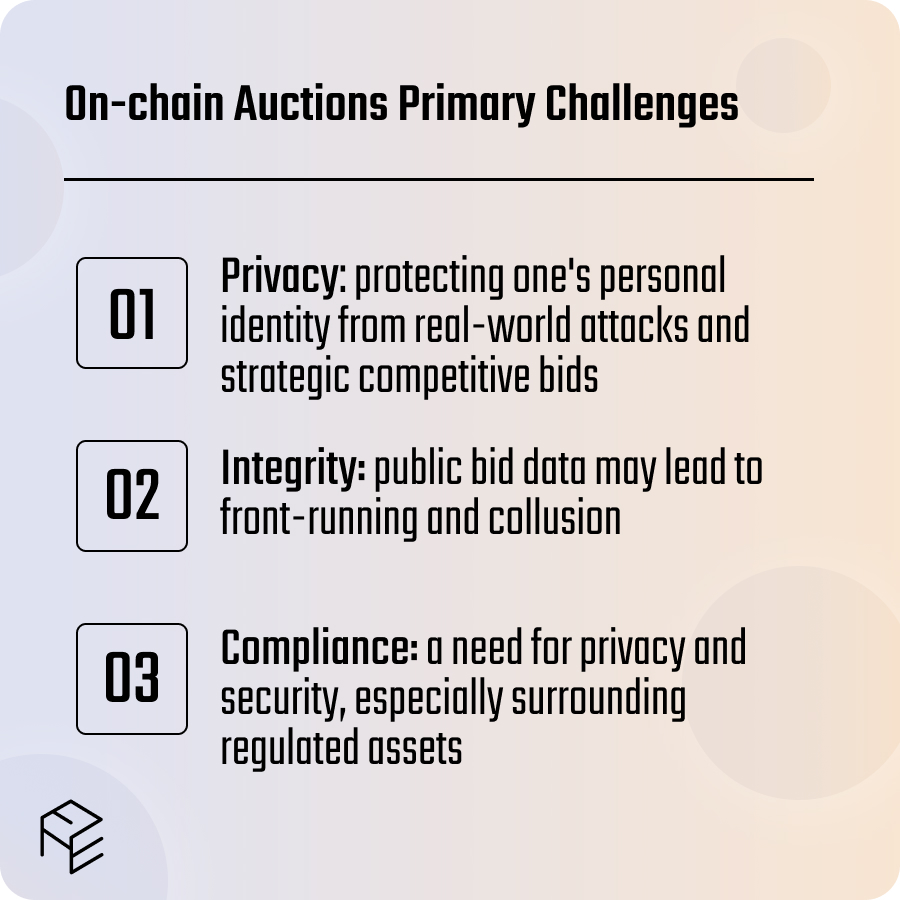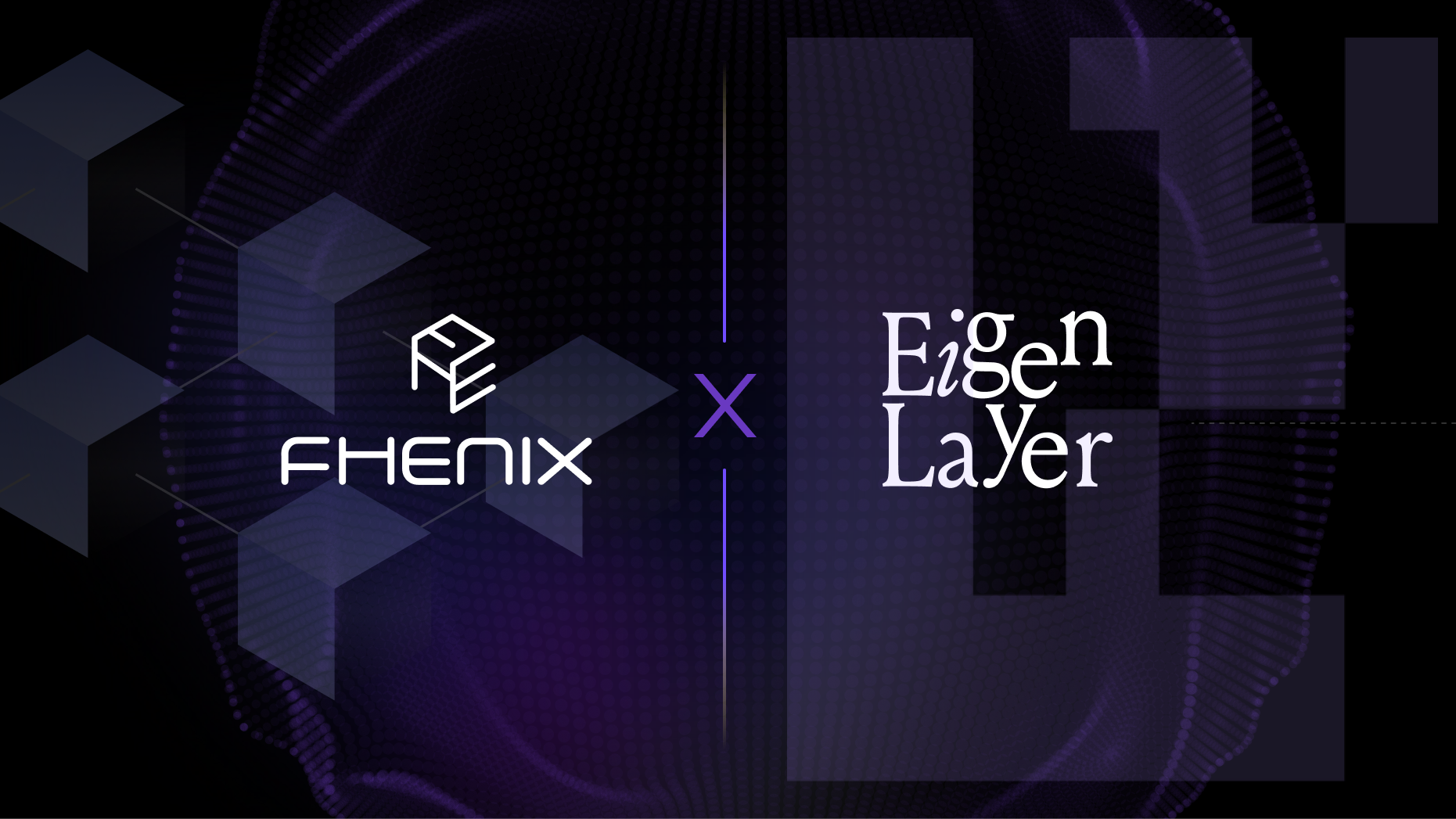
Date: 01-02-24
Invisible Handshakes: On-Chain Blind Auctions with FHE
TLDR:
- On-chain auctions are critical to blockchain, responsible for liquidations, token sales, and more. However, blockchain’s innate transparency results in privacy, integrity, and regulatory compliance remaining major issues for on-chain auctions.
- Privacy is of concern as on-chain auctions can be correlated to one’s real-life identity, making bidders targets for scams.
- Integrity matters as publicly visible bid details on the blockchain could lead to issues such as front-running, collusion, or other forms of manipulation.
- Regulatory compliance is also of relevance as various jurisdictions have strict privacy and data protection laws that require data confidentiality, and strict compliance around regulated assets.
- Fhenix’s FHE Rollups address all of the above, providing customizable Layer-2 infrastructure with built-in privacy and security powered by Fully Homomorphic Encryption. These are easily deployable, with on-chain auctions fully private and secure, yet auditable.
Introduction:
Many areas of blockchain require users to place competitive bids against one another in real-time, known as on-chain auctions. These auctions are critical to both blockchain and decentralized finance (DeFi), responsible for loan liquidations, token sales, NFT marketplace offerings, carbon credits, and more.
A major ongoing challenge is incorporating full privacy and security into them, a consequence of the public nature of blockchains. While having all data public is a benefit in some regards, it can also lead to issues with on-chain auctions, especially surrounding bidder privacy and auction integrity.
Fhenix’s implementation of Fully Homomorphic Encryption (FHE) enables the execution of complex computations on fully encrypted data, maintaining its confidentiality throughout its entire journey. Using FHE, any on-chain auction can be fully encrypted from start to finish, with state updates sent transaction-by-transaction and all data auditable.
In this article we’ll cover the following:
- An Overview of On-Chain Auctions
- Existing Challenges
- FHE’s ability to incorporate privacy and security.
- Fhenix’s FHE Rollups
We’ll cover each in turn, and show why Fhenix’s ability to bring confidential computing on-chain is revolutionary for this sector.
On-Chain Auctions
On-chain auctions use smart contracts to manage and execute an auction, from the initial asset listing to determining the winner and finalizing the transaction.
Auctions are prevalent in the crypto sphere due to factors like the market’s high volatility, which frequently results in the liquidation of positions, the continuous, round-the-clock trading of diverse assets, and the relatively low barriers to entry for participants.
Each category of on-chain auction alone represents a vast sum of funds.
For example, December 11th, 2023 alone saw over $320M in positions liquidations occur, and while a significant fraction took place on centralized exchanges, trading is increasingly moving on-chain. Meanwhile, ICOs, tending to use auctions, have raised over $50B since 2017.
On-chain carbon credits, NFT marketplace sales, and many more areas of blockchain will require well-designed blockchain infrastructure with privacy & security built-in.
Issues with On-Chain Auctions
On-chain auctions currently struggle with 3 primary challenges:
- Privacy
- Integrity
- Compliance
Privacy is an issue as on-chain auctions can be correlated to one’s real-life identity, making bidders targets for scams. For instance, Mark Cuban recently lost nearly $900,000 to a phishing attack, with many other noteworthy phishing attacks such as one against a key Harmony employee that led to the loss of $100M in funds. Additionally, dissecting one’s on-chain actions can lead to strategic bids made based on one’s identity or other factors. We also believe that blind auctions lead to more efficient price discovery, benefitting the entire market.
Integrity is an issue as publicly visible bid details on the blockchain could lead to issues such as front-running, collusion, or other forms of manipulation. For instance, existing or impending bids could be monitored, with a competing being placed at the very last second for a cent more. Encryption keeps bids secret until the auction concludes, creating a level playing field for all participants.
Last of all is regulatory compliance. Certain jurisdictions have strict privacy and data protection laws that require data confidentiality, and strict compliance around regulated assets. This will also increase as more institutions arrive on-chain, as well as regulated assets such as tokenized commodities, real estate, and financial instruments. For example, auctions revolving around regulated assets necessitate strict privacy and security measures, possible through Fully Homomorphic Encryption.
FHE on the Blockchain
Addressing the above challenges and ensuring the complete encryption of on-chain auctions is extremely easy to implement using Fhenix’s FHE Rollups.
FHE Rollups enable developers to craft custom application chains with built-in FHE capabilities while using well-known EVM languages such as Solidity. For example, an NFT marketplace could be its own FHE rollup that easily connects to both external EVM and non-EVM networks, while having all transactions be fully confidential. Concurrently, another interoperable rollup could be centered around fully encrypted Initial Coin Offerings (ICOs).
Developers can easily deploy any custom-purpose Layer 2 with privacy, security, and compliance built-in from the core while knowing that transactions are auditable if need be.
What about drawbacks?
One challenge is that FHE is cutting-edge, meaning that it’s also quite new.
In our 2-part series, we covered 5 separate challenges:
- Part 1 discussed nascent FHE schemes, libraries & compilers, and a need for advanced threshold decryption.
- Part 2 discussed the need for ZKPs for both user inputs & computations, data availability requirements, and the need for improvements in FHE hardware & software.
These technical aspects still require some modification, but progress has been moving extremely quickly and we expect the same for 2024.
Conclusion:
FHE is a superior, albeit relatively new technology that enables encrypted data to be computed.
This is much needed for on-chain auctions, an area of blockchain where users place competitive bids in real time. These auctions are vital for liquidations, NFT marketplaces, ICOs, and more, yet the public nature of the blockchain creates challenges. Not only is bidder data at risk, but so is the auction’s integrity as a whole, and there’s also the challenge of being fully compliant with regulations.
Fortunately, it’s easy for developers to integrate FHE into their workflow using familiar EVM languages, using the fhEVM.
Fhenix’s mission is to usher in a new era of computing, prioritizing privacy and security, and ultimately eliminating data breaches while maintaining confidentiality and data integrity for all.
We also recommend visiting our website at fhenix.io to learn more.



